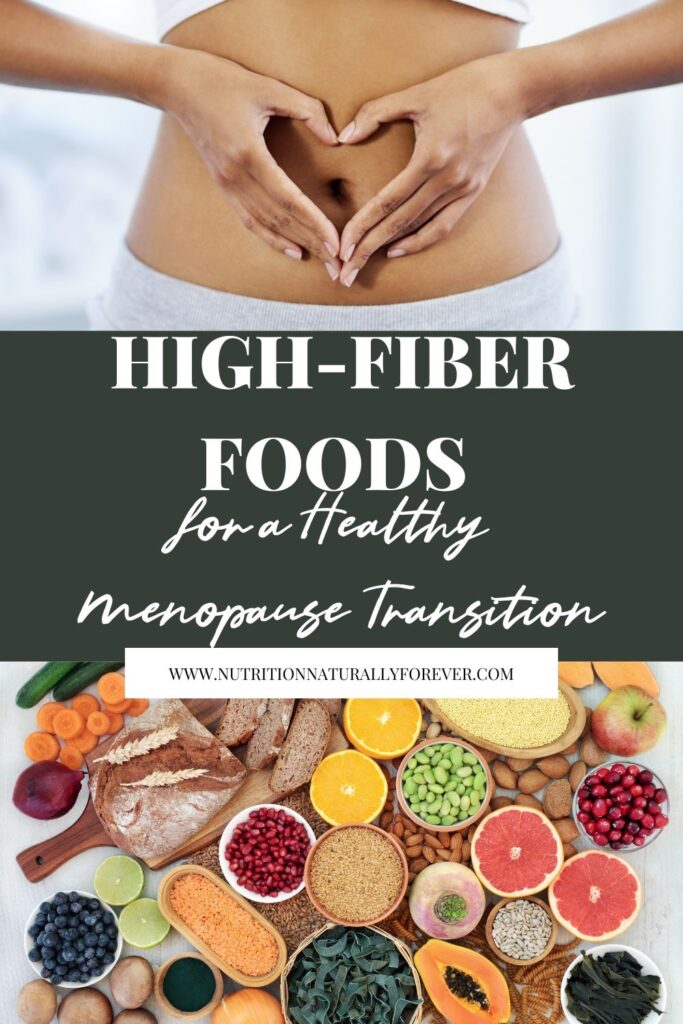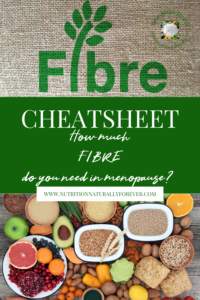
High Fibre Meal Plan for a Healthy Menopause Transition.
If you are a regular reader of my blogs, you will know how I rave about protein for menopause.
However, it is essential to create well-balanced meals, with optimal amounts of protein along with healthy fat and enough fibre to create well-balanced meals to support the overall health of all the systems of the body.
With this in mind, this week I want to bang the drum for fibre.
What is Dietary Fiber?
Dietary fibre, or roughage or bulk, is the indigestible portion of plant foods that passes through the digestive system relatively unchanged.
It’s found in a variety of foods including;
- Whole fruit,
- Raw vegetables,
- Whole grains
- Legumes.
Fibre can not be broken down by the body and does not provide any nutritional value, however, it is extremely important for the body and plays an essential part in digestive health.
There are two types of fibre;
- Soluble fibre dissolves in water to form a gel-like substance in the digestive tract. It can help with blood sugar control and cholesterol levels.
- Insoluble fibre promotes the movement of material through the digestive system and increases stool bulk, which can help prevent constipation.
What Are Biotics?
Biotic means life, therefore, pre-biotics are pre-life.
Fibre is prebiotic, this is the fuel for probiotics, pro-life.
Probiotics are the beneficial species of bacteria, friendly bacteria, found in the body.
Postbiotics are the by-products of probiotics.
These by-products are short-chain fatty acids (SCFA).
SCFA reduce inflammation, increases insulin sensitivity, improves mood and sleep, along with increasing mental cognition.
YES PLEASE to all of that!
What is the best way to get all this goodness into your body?
Start by populating your gut with good bacteria.
You can do this with a good quality supplement which is quick but can be expensive long-term. Using real food is always the best way to nourish your body. Choose foods such as kimchi or saurkraut, kefir, kombucha and natural yoghurt for their probiotic benefits.
Please note, avoid the small yoghurty drinks aimed at improving your gut health, they are packed with sugar and chemicals and in my opinion a complete waste of money plus single-use plastic is bad for the environment. Stick with plain yoghurt, the ingredients should just be milk and cultures and plain kefir, you can pimp it up at home with a cup of raspberries or fruit of your choice to add flavour and fibre.
Once you have populated your gut you need to feed these guys with fibre as described above. The post-biotics take care of themselves.
Health Benefits of Fibre
It’s all very well being told something is healthy and that you need to eat more of it but I always want to know why, which is funny as my infant school headmistress told my mum that I didn’t question things enough! Anyway, I digress…
Understanding why something is good for you and the benefits of going to the trouble of including something as un-sexy as fibre in your high fibre meal plan can help you make something a habit, so here are the health benefits of fibre;
- Promotes Digestive Health: Fibre adds bulk to stools, which helps regulate bowel movements and prevents constipation. It also plays an important role in the growth of beneficial bacteria in the gut, supporting a healthy digestive system.
- Prevents Diverticular Disease: Diverticular disease occurs when small pouches (diverticula) form in the colon. A High fibre diet has been shown to reduce the risk of diverticular disease by promoting regular bowel movements and preventing constipation.
- Lowers Risk of Colorectal Cancer: Adequate fibre intake is associated with a reduced risk of colorectal cancer. Fibre helps move waste through the digestive system quickly, reducing the time that harmful substances are in contact with the colon lining.
- Manages Weight: Fiber-rich foods help you feel full for longer providing satiety from your meals which can aid in weight management. Additionally, a high-fibre diet is associated with lower body weight and reduced risk of obesity.
- Controls Blood Sugar Levels: Soluble fibre slows down the absorption of sugar into the bloodstream, helping to stabilise blood sugar levels. This can be particularly beneficial for individuals with diabetes or those at risk of developing diabetes.
- Lowers Cholesterol Levels: Soluble fibre binds to cholesterol in the digestive tract, preventing its absorption into the bloodstream and ultimately reducing LDL (bad) cholesterol levels. This helps lower the risk of heart disease and stroke.
- Supports Heart Health: In addition to lowering cholesterol levels, high-fibre meals have been linked to a reduced risk of heart disease and improved cardiovascular health overall.
- Promotes Longevity: Studies have suggested that a high-fibre diet may be associated with a longer lifespan and a reduced risk of mortality from various chronic diseases, including cardiovascular disease, cancer, and respiratory diseases.
- Improves Gut Microbiota: Fibre acts as a prebiotic, nourishing beneficial bacteria in the gut. A healthy gut microbiota is essential for overall health, as it supports digestion, nutrient absorption, and immune function.
How much Fibre is enough?
The recommended daily amount of fibre is 25 grams.
Most women don’t get nearly enough averaging about 15 grams per day.
During menopause, your daily amount can be increased to between 30-45 grams as this will increase all the health benefits listed above.
Foods which include fibre are an abundant source of micronutrients, these have the added benefit of not needing to take a supplement which can be expensive and are not as bioavailable as the nutrients through real food.
Nature provides us with a combination of nutrients in each food source, these nutrients provide everything our body needs for optimal absorption.
It is important to note that if your current intake of fibre is low then you should increase your daily amount slowly or you may find you start to suffer from digestive issues. If this happens, cut back until any issues settle and build back up again, slowly. If you suffer from IBS or similar digestive issues you will need to listen to and honour your body’s unique needs.
Fibre Made Easy
To hit your daily fibre goals it helps to create a 7-day meal plan so you can get organised with meal ideas knowing that you are getting the number of grams of fibre you need.
As well as increasing your fibre intake make sure you drink plenty of water to make sure the fibre doesn’t get stuck in your large intestine. The body absorbs water from your food here and too little water can lead to constipation.
Constipation contributes to a lack of hormone harmony.
Hormones are excreted from our body in different ways, one is via our digestive system. A sluggish digestive system can lead to the re-absorption of hormones to be eliminated from the body. Regular bowel movements contribute to hormone harmony.
To support you with your fibre content and to make this as simple as possible I have created a Fibre Cheat Sheet which you can download for free HERE.
If you need some inspiration for creating a high fibre meal plan of your own I have created a done-for-you 7-Day High Fiber Meal Plan. This plan includes an omnivore and plant-based plan along with a prep guide, nutritional information and a shopping list. Learn more HERE.
I hope this encourages you to see what an ally fibre can be to support your menopause health, relieving menopause symptoms and protecting future health and well-being.
If you would like to chat with me about your unique menopause transition, book a Wild Well-Being call and come away inspired and motivated to begin your journey to optimal health.


